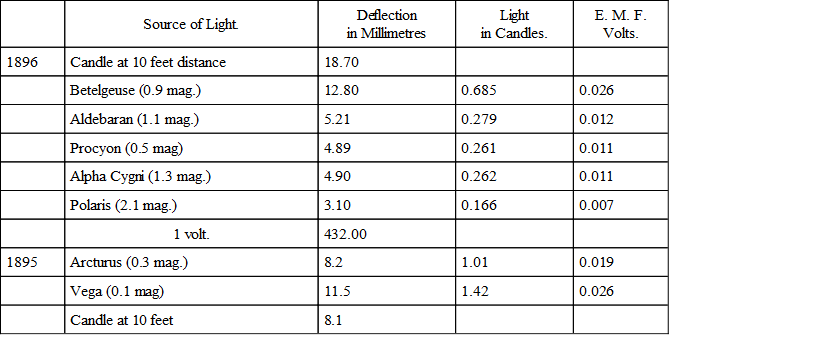 полная версия
полная версияMan's Place in the Universe
Astronomers are so fully occupied with the vast number and variety of the phenomena presented by the stellar universe and the various difficult problems arising therefrom, that many lesser but still interesting inquiries have necessarily received little attention. Such a minor problem is the determination of how much heat or other active radiation we receive from the stars; yet a few observations have been made with results that are of considerable interest.
In the years 1900 and 1901 Mr. E.F. Nichols of the Yerkes Observatory made a series of experiments with a radiometer of special construction, to determine the heat emitted by certain stars. The result arrived at was, that Vega gave about 1/200000000 of the heat of a candle at one metre distance, and Arcturus about 2.2 times as much.
In 1895 and 1896 Mr. G.M. Minchin made a series of experiments on the Electrical Measurement of Starlight, by means of a photo-electric cell of peculiar construction which is sensitive to the whole of the rays in the spectrum, and also to some of the ultra-red and ultra-violet rays. Combined with this was a very delicate electrometer. The telescope employed to concentrate the light was a reflector of two feet aperture. Mr. Minchin was assisted in the experiments by the late Professor G.F. Fitzgerald, F.R.S., of Trinity College, Dublin, which may be considered guarantee of the accuracy of the observations. The following are the chief results obtained:—

N.B.—The standard candle shone directly on the cell, whereas the star's light was concentrated by a 2-foot mirror.
The sensitive surface on which the light of the stars was concentrated was 1/20 inch in diameter. We must therefore diminish the amount of candle light in this table in the proportion of the square of the diameter of the mirror (in 1/20 of an inch) to one, equal to 1/230400. If we make the necessary reduction in the case of Vega, and also equalise the distance at which the candle was placed, we find the following result:—

This enormous difference in the result is no doubt largely due to the fact that Mr. Nichols's apparatus measured heat alone, whereas Mr. Minchin's cell measured almost all the rays. And this is further shown by the fact that, whereas Mr. Nichols found Arcturus a red star, hotter than Vega a white one, Mr. Minchin, measuring also the light-giving and some of the chemical rays, found Vega considerably more energetic than Arcturus. These comparisons also suggest that other modes of measurement might give yet higher results, but it will no doubt be urged that such minute effects must necessarily be quite inoperative upon the organic world.
There are, however, some considerations which tend the other way. Mr. Minchin remarks on the unexpected fact that Betelgeuse produces more than double the electrical energy of Procyon, a much brighter star. This indicates that many of the stars of smaller visual magnitudes may give out a large amount of energy, and it is this energy, which we now know can take many strange and varied forms, that would be likely to influence organic life. And as to the quantity being too minute to have any effect, we know that the excessively minute amount of light from the very smallest telescopic stars produces such chemical changes on a photographic plate as to form distinct images, with comparatively small lenses or reflectors and with an exposure of two or three hours. And if it were not that the diffused light of the surrounding sky also acts upon the plate and blurs the faint images, much smaller stars could be photographed.
We know that not all the rays, but a portion only, are capable of producing these effects; we know also that there are many kinds of radiation from the stars, and probably some yet undiscovered comparable with the X rays and other new forms of radiation. We must also remember the endless variety and the extreme instability of the protoplasmic products in the living organism, many of which are perhaps as sensitive to special rays as is the photographic plate.
And we are not here limited to action for a few minutes or a few hours, but throughout the whole night and day, and continued whenever the sky is clear for months or years. Thus the cumulative effect of these very weak radiations may become important. It is probable that their action would be most influential on plants, and here we find all the conditions requisite for its accumulation and utilisation in the large amount of leaf-surface exposed to it. A large tree must present some hundreds of superficial feet of receptive surface, while even shrubs and herbs often have a leaf-area of greater superficial extent than the object-glasses of our largest telescopes. Some of the highly complex chemical processes that go on in plants may be helped by these radiations, and their action would be increased by the fact that, coming from every direction over the whole surface of the heavens, the rays from the stars would be able to reach and act upon every leaf of the densest masses of foliage. The large amount of growth that takes place at night may be in part due to this agency.
Of course all this is highly speculative; but I submit, in view of the fact that the light of the very faintest stars does produce distinct chemical changes, that even the very minute heat-effects are measureable, as well as the electro-motive forces caused by them; and further, that when we consider the millions, perhaps hundreds of millions of stars, all acting simultaneously on any organism which may be sensitive to them, the supposition that they do produce some effect, and possibly a very important effect, is not one to be summarily rejected as altogether absurd and not worth inquiring into.
It is not, however, these possible direct actions of the stars upon living organisms to which I attach much weight as regards our central position in the stellar universe. Further consideration of the subject has convinced me that the fundamental importance of that position is a physical one, as has already been suggested by Sir Norman Lockyer and some other astronomers. Briefly, the central position appears to be the only one where suns can be sufficiently stable and long-lived to be capable of maintaining the long process of life-development in any of the planets they may possess. This point will be further developed in the next (and concluding) chapter.
CHAPTER XVI
STABILITY OF THE STAR-SYSTEM: IMPORTANCE OF OUR CENTRAL POSITION: SUMMARY AND CONCLUSIONOne of the greatest difficulties with regard to the vast system of stars around us is the question of its permanence and stability, if not absolutely and indefinitely, yet for periods sufficiently long to allow for the many millions of years that have certainly been required for our terrestrial life-development. This period, in the case of the earth, as I have sufficiently shown, has been characterised throughout by extreme uniformity, while a continuance of that uniformity for a few millions of years in the future is almost equally certain.
But our mathematical astronomers can find no indications of such stability of the stellar universe as a whole, if subject to the law of gravitation alone. In reply to some questions on this point, my friend Professor George Darwin writes as follows:—'A symmetrical annular system of bodies might revolve in a circle with or without a central body. Such a system would be unstable. If the bodies are of unequal masses and not symmetrically disposed, the break-up of the system would probably be more rapid than in the ideal case of symmetry.'
This would imply that the great annular system of the Milky Way is unstable. But if so, its existence at all is a greater mystery than ever. Although in detail its structure is very irregular, as a whole it is wonderfully symmetrical; and it seems quite impossible that its generally circular ring-like form can be the result of the chance aggregation of matter from any pre-existing different form. Star-clusters are equally unstable, or, rather, nothing is known or can be predicated about their stability or instability, according to Professors Newcomb and Darwin.
Mr. E.T. Whittaker (Secretary to the Royal Astronomical Society), to whom Professor G. Darwin sent my questions, writes:—'I doubt whether the principal phenomena of the stellar universe are consequences of the law of gravitation at all. I have been working myself at spiral nebulæ, and have got a first approximation to an explanation—but it is electro-dynamical and not gravitational. In fact, it may be questioned whether, for bodies of such tremendous extent as the Milky Way or nebulæ, the effect which we call gravitation is given by Newton's law; just as the ordinary formulæ of electrostatic attraction break down when we consider charges moving with very great velocities.'
Accepting these statements and opinions of two mathematicians who have given special attention to similar problems, we need not limit ourselves to the laws of gravitation as having determined the present form of the stellar universe; and this is the more important because we may thus escape from a conclusion which many astronomers seem to think inevitable, viz. that the observed proper motions of the stars cannot be explained by the gravitative forces of the system itself. In chapter VIII. of this work I have quoted Professor Newcomb's calculation as to the effect of gravitation in a universe of 100 million stars, each five times the mass of our sun, and spread over a sphere which it would take light 30,000 years to cross; then, a body falling from its outer limits to the centre could at the utmost acquire a velocity of twenty-five miles a second; and therefore, any body in any part of such a universe having a greater velocity would pass away into infinite space. Now, as several stars have, it is believed, much more than this velocity, it follows not only that they will inevitably escape from our universe, but that they do not belong to it, as their great velocity must have been acquired elsewhere. This seems to have been the idea of the astronomer who stated that, even at the very moderate speed of our sun, we should in five million years be deep in the actual stream of the Milky Way. To this I have already sufficiently replied; but I now wish to bring before my readers an excellent illustration of the importance of the late Professor Huxley's remark, that the results you got out of the 'mathematical mill' depend entirely on what you put into it.
In the Philosophical Magazine (January 1902) is a remarkable article by Lord Kelvin, in which he discusses the very same problem as that which Professor Newcomb had discussed at a much earlier date, but, starting from different assumptions, equally based on ascertained facts and probabilities deduced from them, brings out a very different result.
Lord Kelvin postulates a sphere of such a radius that a star at its confines would have a parallax of one-thousandth part of a second (0".001), equivalent to 3215 light-years. Uniformly distributed through this sphere there is matter equal in mass to 1000 million suns like ours. If this matter becomes subject to gravitation, it all begins to move at first with almost infinite slowness, especially near its centre; but nevertheless, in twenty-five million years many of these suns would have acquired velocities of from twelve to twenty miles a second, while some would have less and some probably more than seventy miles a second. Now such velocities as these agree generally with the measured velocities of the stars, hence Lord Kelvin thinks there may be as much matter as 1000 million suns within the above-named distance. He then states that if we suppose there to be 10,000 million suns within the same sphere, velocities would be produced very much greater than the known star-velocities; hence it is probable that there is very much less matter than 10,000 million times the sun's mass. He also states that if the matter were not uniformly distributed within the sphere, then, whatever was the irregularity, the acquired motions would be greater; again indicating that the 1000 million suns would be ample to produce the observed effects of stellar motion. He then calculates the average distance apart of each of the 1000 million stars, which he finds to be about 300 millions of millions of miles. Now the nearest star to our sun is about twenty-six million million of miles distant, and, as the evidence shows, is situated in the denser part of the solar cluster. This gives ample allowance for the comparative emptiness of the space between our cluster and the Milky Way, as well as of the whole region towards the poles of the Milky Way (as shown by the diagrams in chapter IV.), while the comparative density of extensive portions of the Galaxy itself may serve to make up the average.
Now, previous writers have come to a different conclusion from the same general line of argument, because they have started with different assumptions. Professor Newcomb, whose statement made some years back is usually followed, assumed 100 million stars each five times as large as our sun, equal to 500 million suns in all, and he distributed them equally throughout a sphere 30,000 light-years in diameter. Thus he has half the amount of matter assumed by Lord Kelvin, but nearly five times the extent, the result being that gravity could only produce a maximum speed of twenty-five miles a second; whereas on Lord Kelvin's assumption a maximum speed of seventy miles a second would be produced, or even more. By this latter calculation we find no insuperable difficulty in the speed of any of the stars being beyond the power of gravitation to produce, because the rates here given are the direct results of gravitation acting on bodies almost uniformly distributed through space. Irregular distribution, such as we see everywhere in the universe, might lead to both greater and less velocities; and if we further take account of collisions and near approaches of large masses resulting in explosive disruptions, we might have almost any amount of motion as the result, but as this motion would be produced by gravitation within the system, it could equally well be controlled by gravitation.
DIAGRAM OF STELLAR UNIVERSE (Plan).

1. Central part of Solar Cluster.
2. Sun's Orbit (Black spot).
3. Outer limit of Solar Cluster.
4. Milky Way.
In order that my readers may better understand the calculations of Lord Kelvin, and also the general conclusions of astronomers as to the form and dimensions of the stellar universe, I have drawn two diagrams, one showing a plan on the central plane of the Milky Way, the other a section through its poles. Both are on the same scale, and they show the total diameter across the Milky Way as being 3600 light-years, or about half that postulated by Lord Kelvin for his hypothetical universe. I do this because the dimensions given by him are those which are sufficient to lead to motions near the centre such as the stars now possess in a minimum period of twenty-five million years after the initial arrangement he supposes, at which later epoch which we are now supposed to have reached, the whole system would of course be greatly reduced in extent by aggregations towards and near the centre. These dimensions also seem to accord sufficiently with the actual distances of stars as yet measured. The smallest parallax which has been determined with any certainty, according to Professor Newcomb's list, is that of Gamma Cassiopeiæ, which is one-hundredth of a second (0".01), while Lord Kelvin gives none smaller than 0".02, and these will all be included within the solar cluster as I have shown it.
DIAGRAM OF STELLAR UNIVERSE (Section).

Section through Poles of Milky Way.
It must be clearly understood that these two illustrations are merely diagrams to show the main features of the stellar universe according to the best information available, with the proportionate dimensions of these features, so far as the facts of the distribution of the stars and the views of those astronomers who have paid most attention to the subject can be harmonised. Of course it is not suggested that the whole arrangement is so regular as here shown, but an attempt has been made by means of the dotted shading to represent the comparative densities of the different portions of space around us, and a few remarks on this point may be needed.
The solar cluster is shown very dense at the central portion, occupying one-tenth of its diameter, and it is near the outside of this dense centre that our sun is supposed to be situated. Beyond this there seems to be almost a vacuity, beyond which again is the outer portion of the cluster consisting of comparatively thinly scattered stars, thus forming a kind of ring-cluster, resembling in shape the beautiful ring-nebula in Lyra, as has been suggested by several astronomers. There is some direct evidence for this ring-form. Professor Newcomb in his recent book on The Stars gives a list of all stars of which the parallax is fairly well known. These are sixty-nine in number; and on arranging them in the order of the amount of their parallax, I find that no less than thirty-five of them have parallaxes between 0".1 and 0".4 of a second, thus showing that they constitute part of the dense central mass; while three others, from 0".4 to 0".75, indicate those which are our closest companions at the present time, but still at an enormous distance. Those which have parallaxes of less than the tenth and down to one-hundredth of a second are only thirty-one in all; but as they are spread over a sphere ten times the diameter, and therefore a thousand times the cubic content of the sphere containing those above one-tenth of a second, they ought to be immensely more numerous even if very much more thinly scattered. The interesting point, however, is, that till we get down to a parallax of 0".06, there are only three stars as yet measured, whereas those between 0".02 and 0".06, an equal range of parallax, are twenty-six in number, and as these are scattered in all directions they indicate an almost vacant space followed by a moderately dense outer ring.
In the enormous space between our cluster and the Milky Way, and also above and below its plane to the poles of the Galaxy, stars appear to be very thinly scattered, perhaps more densely in the plane of the Milky Way than above and below it where the irresolvable nebulæ are so numerous; and there may not improbably be an almost vacant space beyond our cluster for a considerable distance, as has been supposed, but this cannot be known till some means are discovered of measuring parallaxes of from one-hundredth to one five-hundredth of a second.
These diagrams also serve to indicate another point of considerable importance to the view here advocated. By placing the solar system towards the outer margin of the dense central portion of the solar cluster (which may very possibly include a large proportion of dark stars and thus be much more dense towards the centre than it appears to us), it may very well be supposed to revolve, with the other stars composing it, around the centre of gravity of the cluster, as the force of gravity towards that centre might be perhaps twenty or a hundred times greater than towards the very much less dense and more remote outer portions of the cluster. The sun, as indicated on the diagrams, is about thirty light-years from that centre, corresponding to a parallax of a little more than one-tenth of a second, and an actual distance of 190 millions of millions of miles, equal to about 70,000 times the distance of the sun from Neptune. Yet we see that this position is so little removed from the exact centre of the whole stellar universe, that if any beneficial influences are due to that central position in regard to the Galaxy, it will receive them perhaps to as full an extent as if situated at the actual centre. But if it is situated as here shown, there is no further difficulty as to its proper motion carrying it from one side to the other of the Milky Way in less time than has been required for the development of life upon the earth. And if the solar cluster is really sub-globular, and sufficiently condensed to serve as a centre of gravity for the whole of the stars of the cluster to revolve around, all the component stars which are not situated in the plane of its equator (and that of the Milky Way) must revolve obliquely at various angles up to an angle of 90°. These numerous diverging motions, together with the motions of the nearer stars outside the cluster, some of which may revolve round other centres of gravity made up largely of dark bodies, would perhaps sufficiently account for the apparent random motions of so many of the stars.
Uniform Heat-Supply due to Central PositionWe now come to a point of the greatest interest as regards the problem we are investigating. We have seen how great is the difference in the estimates of geologists and those of physicists as to the time that has elapsed during the whole development of life. But the position we have now found for the sun, in the outer portion of the central star-cluster, may afford a clue to this problem. What we require is, some mode of keeping up the sun's heat during the enormous geological periods in which we have evidence of a wonderful uniformity in the earth's temperature, and therefore in the sun's heat-emission. The great central ring-cluster with its condensed central mass, which presumably has been forming for a much longer period than our sun has been giving heat to the earth, must during all this time have been exerting a powerful attraction on the diffused matter in the spaces around it, now apparently almost void as compared with what they may have been. Some scanty remnants of that matter we see in the numerous meteoric swarms which have been drawn into our system. A position towards the outside of this central aggregation of suns would evidently be very favourable for the growth by accretion of any considerable mass. The enormous distance apart of the outer components (the outer ring) of the cluster would allow a large amount of the inflowing meteoritic matter to escape them, and the larger suns situated near the surface of the inner dense cluster would draw to themselves the greater part of this matter.23 The various planets of our system were no doubt built up from a portion of the matter that flowed in near the plane of the ecliptic, but much of that which came from all other directions would be drawn towards the sun itself or to its neighbouring suns. Some of this would fall directly into it; other masses coming from different directions and colliding with each other would have their motion checked, and thus again fall into the sun; and so long as the matter falling in were not in too large masses, the slow additions to the sun's bulk and increase of its heat would be sufficiently gradual to be in no way prejudicial to a planet at the earth's distance.
The main point I wish to suggest here is, that by far the greater portion of the matter of the whole stellar universe has, either through gravitation or in combination with electrical forces, as suggested by Mr. Whittaker, become drawn together into the vast ring-formed system of the Milky Way, which is, presumably, slowly revolving, and has thus been checked in its original inflow toward the centre of mass of the stellar universe. It has also probably drawn towards itself the adjacent portions of the scattered material in the spaces around it in all directions.
Had the vast mass of matter postulated by Lord Kelvin acquired no motion of revolution, but have fallen continuously towards the centre of mass, the motions developed when the more distant bodies approached that centre would have been extremely rapid; while, as they must have fallen in from every direction, they would have become more and more densely aggregated, and collisions of the most catastrophic nature would frequently have occurred, and this would have rendered the central portion of the universe the least stable and the least fitted to develop life.
But, under the conditions that actually prevail, the very reverse is the case. The quantity of matter remaining between our cluster and the Milky Way being comparatively small, the aggregation into suns has gone on more regularly and more slowly. The motions acquired by our sun and its neighbours have been rendered moderate by two causes: (1) their nearness to the centre of the very slowly aggregating cluster where the motion due to gravitation is least in amount; and (2) the slight differential attraction away from the centre by the Milky Way on the side nearest to us. Again, this protective action of the Milky Way has been repeated, on a smaller scale, by the formation of the outer ring of the solar cluster, which has thus preserved the inner central cluster itself from a too abundant direct inflow of large masses of matter.











